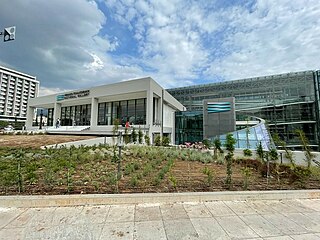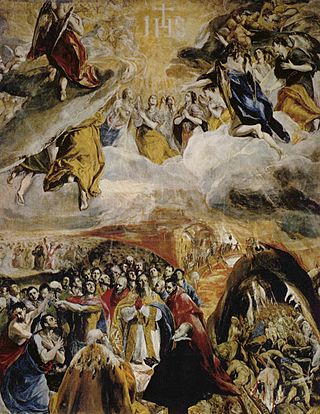
Adoration of the Shepherds is the name of numerous paintings depicting an episode in the story of Jesus's nativity in which shepherds are near witnesses to his birth in Bethlehem, arriving soon after he is actually born. The episode is recounted, or at least implied, in the Gospel of Luke and follows on from the annunciation to the shepherds, in which the shepherds are summoned by an angel to the scene of the birth. Like the episode preceding it, the adoration is a common subject in art, where it is often combined with the Adoration of the Magi. In such cases it is typically just referred to by the latter title.

The Galleria Nazionale d'Arte Antica or National Gallery of Ancient Art is an art museum in Rome, Italy. It is the principal national collection of older paintings in Rome – mostly from before 1800; it does not hold any antiquities. It has two sites: the Palazzo Barberini and the Palazzo Corsini.
Events from the year 1614 in art.

The Adoration of the Shepherds is a painting of the traditional subject which was painted during the last year of El Greco's life. The painting is a work which the artist made to hang over his own tomb in the convent of Santo Domingo el Antiguo in Toledo. His signature, in Greek, may be seen in the lower left corner.

Dormition of the Virgin is a tempera painting on panel executed by El Greco near the end of his Cretan period, probably before 1567. El Greco's signature on the base of the central candelabrum was discovered in 1983. The discovery of the Dormition led to the attribution of three other signed works of "Doménicos" to El Greco and then to the acceptance as authentic of more works, signed or not.
The Annunciation is the biblical episode of the announcement by the archangel Gabriel to Mary that she would become the mother of Jesus.
Events from the year 1609 in art.

The National Gallery is an art museum located on Vasilissis Sofias avenue in the Pangrati district, Athens, Greece. It is devoted to Greek and European art from the 14th century to the 20th century.

Friar Juan Bautista Maíno, or Mayno was a Spanish Baroque painter.

The Nativity of Jesus has been a major subject of Christian art since the 4th century.

The Modena Triptych is 1568 triptych by the artist El Greco, who was also known as Doménikos Theotokópoulos.

The Monastery of Saint Dominic of Silos (the Old) (Spanish: Monasterio de Santo Domingo de Silos (el Antiguo)) is a Cistercian convent in Toledo, Spain.

Adoration of the Shepherds is the title of a lost drawing by Raphael, described in a letter of 8 September 1508, from Raphael to his friend Francesco Raibolini alias Francesco Francia. This letter's contents were first published in 1678, in Carlo Cesare Malvasia's book Felsina Pittrice. Malvasia gave a full account of the letter, which he claimed to have found among the papers of Count Antonio Lambertini in Bologna. While the existence and contents of the letter are disputed, according to Malvasia it described the delivery of a drawing of the Adoration of the Shepherds to Francesco Francia. This drawing has been considered lost or never to have existed.
The Doña María de Aragón Altarpiece was an altarpiece painted between 1596 and 1599 by El Greco for the chapel of the Colegio de la Encarnación in Madrid. The college was secularised during Goya's lifetime and the altarpiece was dismantled. There has been much speculation over which paintings belonged to the work. The consensus view is that it consisted of six large canvases and a seventh, now lost. Five of those six canvases are now in the Prado and the sixth is in the National Museum of Art of Romania in Bucharest.

The Adoration of the Shepherds is a painting of the traditional subject which was painted by El Greco in 1596. It is in the European painting collection of the National Museum of Art of Romania. This unusually tall painting is a work in the group of equally tall paintings which the artist made as part of his 1596 commission known as the Doña María de Aragón Altarpiece for the Colegio de Dona Maria de Aragón in a building that is now the location of Palacio del Senado in Madrid. El Greco's signature, in Greek, may be seen on the paper in the lower left corner.

Nativity is a 1603-1605 painting of the Nativity of Jesus by El Greco. It was one of five paintings painted for the high altarpiece of the Santuario de Nuestra Señora de la Caridad in Illescas, Toledo. It and three others still hang there, whilst the fifth is in the National Museum of Art of Romania.

Adoration of the Holy Name of Jesus is a 1577-1579 oil on canvas painting by El Greco, produced early in his Toledo period and now in the exibith at the Galerias Reales in Madrid. It is also known in modern scholarship as La Gloria, The Dream of Philip II or Allegory of the Holy League.

The Adoration of the Magi is an oil painting executed ca. 1565–1567 by El Greco. It and his St Luke Painting the Madonna and Child are his most western works, with Adoration showing the particularly strong influence of Parmigianino at this time in his career. It may have been painted in Venice or elsewhere during his stay in Italy or for an Italian client living in the painter's native Crete, but this is debated. It is now in the Benaki Museum in Athens.
The Adoration of the Magi is a subject in Christian art.
This page is based on this
Wikipedia article Text is available under the
CC BY-SA 4.0 license; additional terms may apply.
Images, videos and audio are available under their respective licenses.













